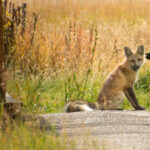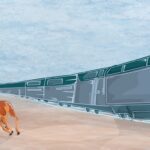Booming elk numbers create a rare opportunity for hunting and tourism
By Janey Fugate
While scouting for mule deer on a chilly October evening in southeast Wyoming, the last thing I expected to see was several hundred elk. But there they were, at last light, filtering over the crest of a bare ridge and winding down the valley floor towards a river. Awestruck, I watched from a crouch. Cold eventually forced me to my feet and I started moving back along the hillside towards my car. As I walked, blaze orange vests alerted me to the presence of three other hunters lying behind a rock, rifles at the ready. I knew that they were waiting for the elk to step across an invisible line onto public land.
 This image of three hunters watching a band of wary elk moving across a darkening landscape has stayed with me. Elk numbers are up across Wyoming, creating more hunt opportunities and possibly more funding for state wildlife agencies. At the same time, this ties to a host of management challenges related to changing property ownership, balancing in-state versus out of state tag allocations and finding enough access to private and public land for more hunters on the landscape. While these challenges aren’t unique to Wyoming, they are particularly acute here as the state moves to adapt to a growing outdoor recreation industry.
This image of three hunters watching a band of wary elk moving across a darkening landscape has stayed with me. Elk numbers are up across Wyoming, creating more hunt opportunities and possibly more funding for state wildlife agencies. At the same time, this ties to a host of management challenges related to changing property ownership, balancing in-state versus out of state tag allocations and finding enough access to private and public land for more hunters on the landscape. While these challenges aren’t unique to Wyoming, they are particularly acute here as the state moves to adapt to a growing outdoor recreation industry.
Against this backdrop, the state is leveraging its need to control elk numbers with a desire to boost the outdoor recreation economy through increasing nonresident tag allocations, with implications for game managers, landowners, and hunters.
~
In the age of environmental crises, it’s unusual to hear of a wild animal that’s thriving. But in Wyoming, elk are at historic highs. In the 1980s, the state had an estimated 65,000 elk. Since then, elk populations have nearly doubled to reach over 120,000. Barring a few herds in the northwest, elk today exceed the desired numbers determined by game managers.
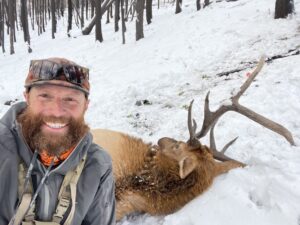
“It’s the heyday of elk. It really is,” says Lee Knox, a wildlife biologist for the Wyoming Game and Fish Department. Knox attributes elk population growth to a range of factors, including elk’s adaptability to different habitats and food sources relative to other hoofed mammals, their long-lived nature, and ability to learn to avoid hunters by hanging out on private lands.
Another major, though indirect, contributor to elk abundance could be a lessening of hunting pressure driven by changing landownership and changing landowner values. What were once large working ranches that supported hunting are now often divided into smaller ranchettes and developments, where elk are viewed less as a nuisance or a hunting resource and more as an attractive feature of the property. On the flip side, some landowners have consolidated large ranches that are less open to hunters than in the past, effectively locking up herds of elk from hunting pressure. This is particularly relevant in eastern Wyoming, where the amount of private property drastically limits hunter access compared to the western part of the state, causing hunters to crowd into patchy public lands.
While having too many elk is certainly a better problem to solve than its opposite, overpopulated elk can take a toll on the landscape. Elk can damage fences and get into haystacks or crops, compete with mule deer for habitat, and can be tough on willow and aspen stands, which are already declining as the climate gets drier.
Yet, elk are one of the most coveted kinds of quarry by both nonresident and resident hunters. As such, elk offer a particularly salient window into how big game hunting, a $250 million industry in Wyoming, fits into the tension around how to grow the state’s recreation economy while best managing habitat, access, and hunter satisfaction.
The Wyoming Wildlife Taskforce—a group of stakeholders from around the state that formed to tackle issues related to wildlife management and the sporting industry—may have found a way to bring elk to more sustainable levels. Their proposal could reap the economic benefits of attracting more out-of-state elk hunters, who pay significantly more than Wyoming residents to hunt. They proposed several legislative changes to elk hunt management in the state.
The first change was to remove a longstanding 7,250 cap on nonresident elk tags. The state legislature approved this change, which will go into effect in 2024. The demand for these tags has steadily exceeded their availability. According to the Wyoming Game and Fish Department, in 2022 there were 30,000 applications from out-of-state hunters for the 7,250 allotted elk tags.
In addition to removing the cap, the taskforce recommended splitting the nonresident tags into two categories: special (40 percent) and regular licenses (60 percent). The price of nonresident special licenses, which are designated for coveted hunt areas that offer higher rates of success on larger, mature animals, will increase to just under $2,000. For the regular tags, the nonresident price will remain at its current level of $692.
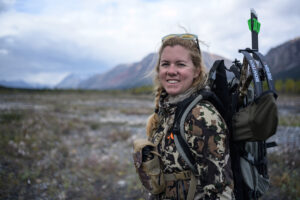
Boosting the number of licenses allotted for nonresident hunters like the taskforce proposed can be controversial when it’s perceived as taking away opportunities for in-state folks. This can be especially sensitive in Wyoming because the state already has higher nonresident tag allocations than neighboring states. Compared to Montana, which limits nonresidents to 10 percent of the available tags, Wyoming allocates 16-20 percent of elk, deer, and pronghorn tags to nonresidents. Jess Johnson, policy coordinator for the Wyoming Wildlife Federation, a sportsmen’s advocacy organization, says that maintaining a culture that prioritizes in-state hunters is a critical concern for residents.
“A fundamental part of being from these states is the ability to draw these tags,” she says. “Hunting, fishing, and trapping is a constitutional right in the state of Wyoming. Folks are very protective over it, understandably.”
According to the taskforce, these changes will not affect resident elk prices or the quantity of tags available to resident hunters, but they will affect Game and Fish’s budget—for the better.
Currently, 80 percent of the Wyoming Game and Fish Department’s budget is funded from hunting license fees. And 80 percent of that 80 percent comes from out-of-state tags. For example, an elk tag that currently costs nonresidents $692 is only $57 for residents. Doubling the price of a portion of these nonresident tags for elk, as well as deer and pronghorn, like the taskforce proposed has the potential to boost Game and Fish’s $90 million budget by 6 percent, adding an estimated $5.7 million in revenue each year.
“To me, that’s a win-win when you can approach the market value of a product and help your state agency,” says Sy Gilliland, president of the Wyoming Outfitters and Guides Association and a member of the taskforce.
According to an economic survey conducted by the Wyoming Outfitters and Guides Association, the number of nonresident hunters applying increased by 10 percent from 2015 to 2020, reflecting a broader trend in big game hunting. With shows like Meateater popularizing hunting and a growing desire to eat ethically harvested meat, the demand for western hunting isn’t showing signs of slowing down. And Wyoming is well positioned to capitalize on it.
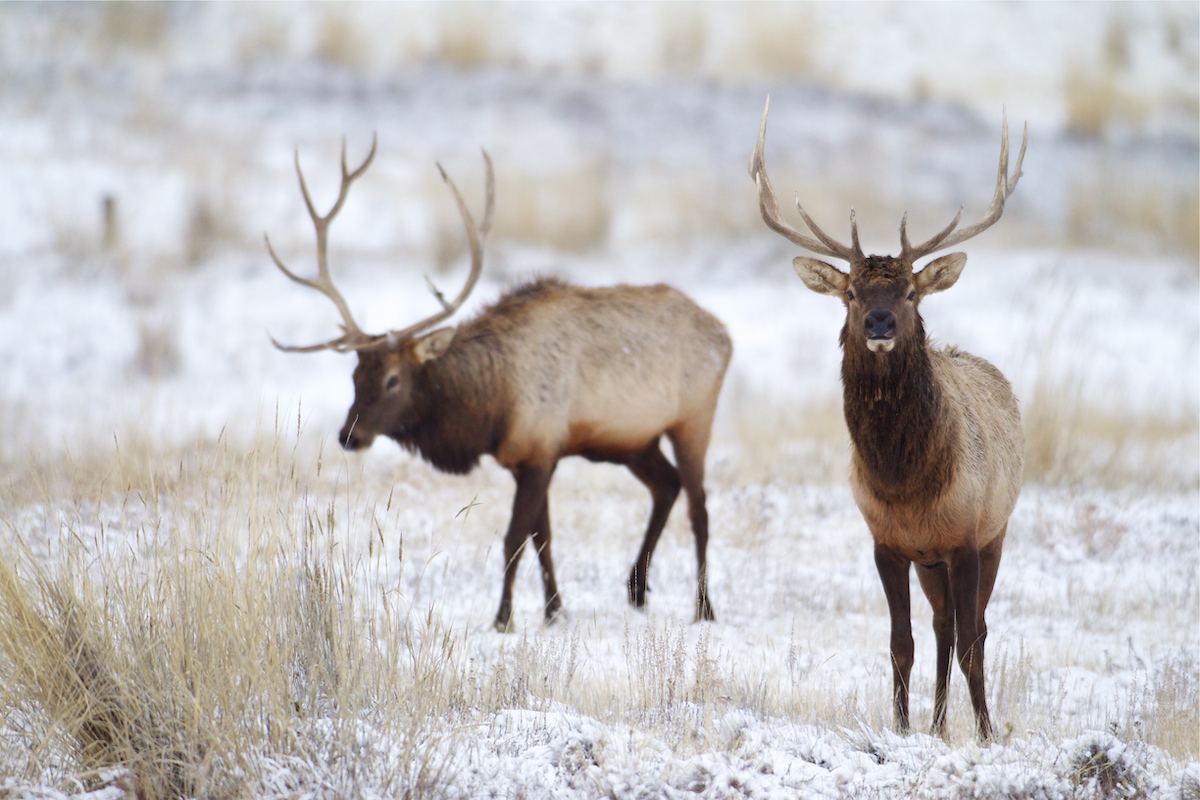
“We have a world-class wildlife resource, and the world knows it,” says Gilliland. “Elk hunting right now is the best it’s ever been in modern history. [People] want to come here and experience it, so raising the cost of licenses can slow down or recoup the real value of that license.”
Gilliland has been guiding hunters all over Wyoming since 1977. Owning the state’s largest outfitting business, he’s led black bear hunts, moose hunts, and everything in between. As an outfitter, Gilliland also occupies a unique space in the cross section of hunters’ values. Outfitters need nonresident hunters to support their businesses, while still desiring the solitude, abundant wildlife, and public lands access that residents cherish.
He hopes that the change in the nonresident tag quota will indirectly benefit his industry, and Wyoming. His logic is that nonresidents willing to pay for the higher price of an elk tag may be more willing to hire a guide.
“The best bang for your buck is to put that license in the hand of a nonresident using outfitters,” says Gilliland. “He leaves the most dollars on the landscape.”
And repeat customers are the easiest the retain. Jim Moore, a Virginia native, has been coming with his son to hunt elk in the Wyoming backcountry for the last 10 years. Moore says that for him, harvesting a bull elk is just a part of the deeper experience of being immersed in nature. While telling me about his hunts, he described sharing a kill with a red fox that helped itself to Moore’s elk carcass, finding wolf tracks in the snow, and nervously keeping watch on a nearby grizzly bear while his guide field dressed their elk. With his outfitters, he’s hunted both private and public land.
“It’s a real opportunity for people that they can use commonly owned land,” says Moore. “It’s millions and millions of acres of opportunity for people.”
~
And while it’s true that the opportunities to hunt public land are vast and worth celebrating, Wyoming’s overabundant elk are just as often found on private lands. This is where access comes in, a hunting buzzword. Increasing access to both private and public land is a big piece of the puzzle. Both Knox and Gilliland believe that nonresidents may be more willing to hunt private lands—and pay the steep fees landowners often charge for access—than residents are. For instance, in eastern Wyoming, Knox says local hunters are more likely to travel elsewhere in the state for hunt opportunities rather than try to get access to private lands.
“Most [residents] will go west if you allow it because there is more public land,” says Knox.
Gaining permission to hunt on private land presents a barrier for hunters that don’t have existing relationships with the landowner. When I watched the three hunters hiding on the ridge, they had no alternative other than to wait at a distance and pray the elk would cross onto public land. Similarly, in Area 7, a hunt unit near Laramie Peak, there were roughly 1,000 elk tags sold to hunters, but the hunter success rate was only 30 percent. In this area, there’s not a shortage of public land, but a lack of access to the private land where the elk hang out.
Private lands can even inadvertently prevent public lands from being accessible, an issue recently brought to the forefront of national news with the now infamous “corner crossing” case. In 2021, a landowner sued four out-of-state hunters for crossing a corner of his ranch to access public land on Elk Mountain they drew elk tags for. This more than $7 million lawsuit, still ongoing, pits the rights of public users against the rights of private landowners, adding to the friction felt around the West.
“The relationship between landowners and hunters is breaking down,” Johnson says. “There’ve been bad actors on both sides, frankly.”
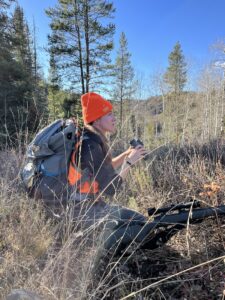
This dynamic is painfully real to Ross Cook, a hunting mentor of mine whose family has owned a ranch outside Lander for the last 35 years. A few years ago, he caught two hunters going to retrieve a mule deer buck they shot illegally on his property. This is a more extreme case of the kinds of harmful behavior that deter landowners from opening their properties to hunters, but it illustrates a rising lack of trust.
“I have zero interest in letting people come and hunt that I haven’t shot with and worked with,” says Cook. “Vetting someone is really hard and most ranchers don’t have time for that.”
There are many reasons why landowners may not want hunters on their property, despite how much money people will pay for access. These range from not wanting the hassle of managing strangers and concerns over ensuring safety to not agreeing with shooting animals on principle. But for Cook, it comes down to finding hunters that share his ethics.
“I would love for people I know who have elk tags to come up to my land and go to town… but finding individuals you can trust is really hard.”
Landowners may have another reason not to allow elk hunters on their land. Cook says that landowners often claim money in elk-related property damages from Game and Fish instead of allowing hunters on their land, which incentivizes a cycle of limited access and over-abundant elk. Programs like Game and Fish’s “Access Yes,” where landowners can make their property open to hunting, address this dilemma but haven’t seen much success.
So bridging a desire to capitalize on nonresident hunters’ dollars with the potential to knock back elk populations is complicated on a lot of levels. The next step may be to match a rise in nonresident hunters with properties willing to let them hunt elk.
“How do we get more hunting pressure on reservoirs of private property?” asks Gilliland. “The best bet for that is to put more licenses in the hands of nonresidents who have the ability to hunt that land and have the ability to pay landowners.”
~
Hand in hand with removing the 7,250 cap on nonresident elk tags is a taskforce proposal to create new nonresident elk hunting units to change how managers can distribute hunters across the landscape. These changes signal how Wyoming is grappling with a growing demand for western hunting and a desire to both protect its wildlife and maintain its identity in a changing West.
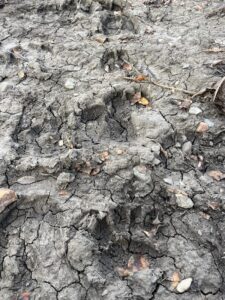
And though distrust between landowners and hunters is a thorny issue, some of these challenges may hopefully open the door to creative solutions that give hunters access to private property where elk congregate. For example, in other parts of the state and the region, online startups are connecting recreationists to private landowners with hunt opportunities, similar to Airbnb for hunting.
The economic benefits of attracting and capitalizing on nonresident hunters and the revenue they might bring to the state are significant, as is the potential to bring elk to more sustainable levels.
But for Gilliland, there is another, less tangible benefit to welcoming more nonresident hunters to Wyoming.
“We change lives, I have seen it so many times. [Hunters] are so grateful to the state of Wyoming for this opportunity,” he says. “I’ve guided congressman, they are hunting their public lands… when they come out here and they see their wilderness for the first time, they are advocates and they go home and help form policy.”
Janey Fugate is a storyteller and a master’s student with the Zoology and Physiology Department at the University of Wyoming under Matthew Kauffman. Her research focuses on how Yellowstone bison, after being reintroduced to the park, established the migration patterns they exhibit today.
Header image: Elk stand silhouetted against a sunset in Wyoming. (Shutterstock)

